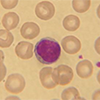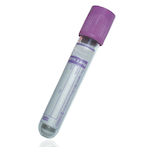HbA1c (Glycated haemoglobin)
Specimen Volume
4mLSpecimen Transport
Standard transport to laboratorySample Preparation
Turnaround Time
24 hoursGeneral Information
For more information please see https://labtestsonline.org.uk/tests/hba1c-test
Notes
Samples that meet the following criteria will not be processed:
- Samples from patients who have been transfused within the last 4 months. Only in exceptional circumstances should such samples be processed and only after discussion with Senior laboratory staff or Haematology medical staff.
- Samples taken from IV “lines” should not be used. Contamination with saline will affect the chromatographic separation of the haemoglobin molecules due to changes to the buffer system/gradients.
- A sample volume of <1ml.
- Samples which fail the minimum data set.
- Clotted samples.
Glycohaemoglobin (GHb) is a general term for whole blood glucose complexes that are non-enzymatically bound to alpha and beta chains of human haemoglobin. The most quantitatively prevalent complex is called HbA1C, in which glucose binds to the N-terminus of the alpha chain. The amount of HbA1c formed is directly related to the average level of blood glucose. HbA1c levels do not change quickly due to life span of red blood cells (2-3 months), therefore the HbA1c levels reflects the average blood glucose level during the last 2-4 months. HbA1c measurement is used in the monitoring of diabetes.
In 2011 the WHO advocated the use of HbA1c testing in diagnosing diabetes.
Haemoglobin A1c (HbA1c) testing to diagnose diabetes
An HbA1c of 48mmol/mol (6.5%) is recommended as the cut off point for diagnosing diabetes. A value of less than 48mmol/mol (6.5%) does not exclude diabetes diagnosed using glucose tests.
In patients without symptoms of diabetes the laboratory venous HbA1c should be repeated. If the second sample is <48mmol/mol (6.5%) the person should be treated as at high risk of diabetes and the test should be repeated in 6 months or sooner if symptoms develop.
Situations where HbA1c is not appropriate for diagnosis of diabetes:
ALL children and young people
patients of any age suspected of having Type 1 diabetes
patients with symptoms of diabetes for less than 2 months
patients at high risk who are acutely ill (e.g. those requiring hospital admission)
patients taking medication that may cause rapid glucose rise e.g. steroids, antipsychotics
patients with acute pancreatic damage, including pancreatic surgery
in pregnancy
presence of genetic, haematologic and illness-related factors that influence HbA1c and its measurement (see annex 1 of the WHO report for a list of factors which influence HbA1c and its measurement)
Patients whose HbA1c is under 48 mmol/mol (6.5%)
These patients may still fulfill WHO glucose criteria for the diagnosis of diabetes
The use of such glucose tests is not recommended routinely, but use WHO glucose testing in patients who have symptoms of diabetes or clinically are at very high risk of diabetes
Reference Range
20-42 mmol/mol
Source of Reference Range
WHOSpecifications
- EQA Status: NEQAS
- EQAS Scheme: Yes








